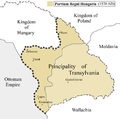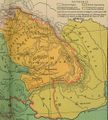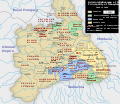إمارة ترانسلڤانيا (1570–1711)
Principality of Transylvania Principatus Transsilvaniae | |||||||||
|---|---|---|---|---|---|---|---|---|---|
| 1570–1711 | |||||||||
| المكانة | Vassal state of the Ottoman Empire Hungarian Crown Land | ||||||||
| العاصمة | Alba Iulia (Gyulafehérvár) 1570–1692 Cibinium (Nagyszeben/Hermannstadt) 1692–1711 | ||||||||
| اللغات الشائعة | Latin (in administration, science and politics); Hungarian (in the Diet and legislation[1][2][3][4]), German, Romanian, Ruthenian (vernacular). | ||||||||
| الدين | Roman Catholicism, Calvinism, Lutheranism, Eastern Orthodoxy, Greek Catholicism, Unitarianism, Judaism | ||||||||
| الحكومة | Principality, Elective monarchy | ||||||||
| Rulers | |||||||||
• 1570–1571 | John II Sigismund Zápolya (first) | ||||||||
• 1704–1711 | Francis II Rákóczi (last) | ||||||||
| التشريع | Transylvanian Diet | ||||||||
| التاريخ | |||||||||
• تأسست | 1570 | ||||||||
| 1699 | |||||||||
• انحلت | 1711 | ||||||||
| |||||||||
| Today part of | |||||||||
The Principality of Transylvania (ألمانية: Fürstentum Siebenbürgen; مجرية: Erdélyi Fejedelemség; لاتينية: Principatus Transsilvaniae; رومانية: Principatul Transilvaniei or Principatul Ardealului) was a semi-independent state, ruled primarily by Hungarian princes.[6][7][8][9][10][11] Its territory, in addition to the traditional Transylvanian lands, also included eastern regions of Hungary, called Partium. The establishment of the principality was connected with Treaty of Speyer.[12][13] However Stephen Báthory's status as king of Poland also helped to phase in the name Principality of Transylvania.[14] It was usually under the suzerainty of the Ottoman Empire; however, the principality often had dual vassalage (Ottoman Turkish sultans and the Habsburg Hungarian kings) in the 16th and 17th centuries.[15][16]
The principality continued to be a part of the Lands of the Hungarian Crown[17] and was a symbol of the survival of Hungarian statehood.[18] It represented the Hungarian interests against Habsburg encroachments in Habsburg ruled Kingdom of Hungary.[19] All traditional Hungarian law remained to be followed scrupulously in the principality;[15] furthermore, the state was imbued with a preponderantly Protestant feature.[20] After the unsettled period of Rákóczi's War of Independence, it became part of the Habsburg Monarchy.
| جزء من سلسلة عن |
| تاريخ المجر |
|---|
 |
| التاريخ القديم |
| قبل التاريخ |
| العصور الوسطى |
| المجر في العصور الوسطى (896–1526) |
| الحروب العثمانية المجرية |
| المجر أوائل العصر الحديث |
| المجر الملكية |
| إمارة ترانسلڤانيا |
| تاريخ المجر 1700–1918 |
| القرن 19 |
| ثورة 1848–49 |
| القرن 20 |
| المجر في الحرب العالمية الأولى |
| فترة بين الحربين (1918–41) |
| المجر في الحرب العالمية الثانية |
| الجمهورية الشعبية 1949–89 |
| ثورة 1956 |
| 1989 – الآن |
| موضوعات في التاريخ المجري |
| التاريخ العسكري |
| تاريخ سيكي |
| تاريخ اليهود في المجر |
| التاريخ الموسيقي |
| تاريخ ترانسلڤانيا |
| The Csangos |
|
|
. . . . . . . . . . . . . . . . . . . . . . . . . . . . . . . . . . . . . . . . . . . . . . . . . . . . . . . . . . . . . . . . . . . . . . . . . . . . . . . . . . . . . . . . . . . . . . . . . . . . . . . . . . . . . . . . . . . . . . . . . . . . . . . . . . . . . . . . . . . . . . . . . . . . . . . . . . . . . . . . . . . . . . . .
Background
Eastern Hungarian Kingdom and Zápolya family
إمارة ترانسلڤانيا
Gallery
The Principality of Transylvania, the successor of Eastern Hungarian Kingdom (1570). Partium is depicted in the darker colour
The partition of medieval Kingdom of Hungary between the Ottoman and Habsburg empires lasted more than 150 years[21] after the Battle of Mohács in 1526
See also
== المراجع ==
- ^ Tamásné Szabó, Csilla, Az Erdélyi Fejedelemség korának jogi nyelve (The jurisdictional language in the age of the Principality of Transylvania)
- ^ Szabó T. Attila, Erdélyi Magyar Szótörténeti Tár (Historical dictionary of the Transylvanian Hungarian vocabulary)
- ^ Compillatae Constitutiones Regni Transylvaniae (1671)
- ^ Approbatae Constitutiones Regni Transylvaniae (1677)
- ^ خطأ استشهاد: وسم
<ref>غير صحيح؛ لا نص تم توفيره للمراجع المسماةBritannica - ^ Helmut David Baer (2006). The struggle of Hungarian Lutherans under communism. Texas A&M University Press. pp. 36–. ISBN 978-1-58544-480-9. Retrieved 14 July 2011.
- ^ Eric Roman (2003). Austria-Hungary & the successor states: a reference guide from the Renaissance to the present. Infobase Publishing. pp. 574–. ISBN 978-0-8160-4537-2. Retrieved 14 July 2011.
- ^ J. Atticus Ryan; Christopher A. Mullen (1998). Unrepresented Nations and Peoples Organization: yearbook. Martinus Nijhoff Publishers. pp. 85–. ISBN 978-90-411-1022-0. Retrieved 14 July 2011.
- ^ Iván Boldizsár (1987). NHQ; the new Hungarian quarterly. Lapkiadó Pub. House. p. 41. Retrieved 14 July 2011.
- ^ Marshall Cavendish (2009). "Greece and the Eastern Balkans". World and Its Peoples: Europe. Vol. 11. Marshall Cavendish. p. 1476. ISBN 978-0-7614-7902-4. Retrieved 14 July 2011.
- ^ Paul Lendvai (2003). The Hungarians: a thousand years of victory in defeat. C. Hurst. pp. 106–. ISBN 978-1-85065-673-9. Retrieved 14 July 2011.
- ^ Richard C. Frucht, Eastern Europe: An Introduction to the People, Lands, and Culture, Volume 1, ABC-CLIO, 2004, p. 408
- ^ خطأ استشهاد: وسم
<ref>غير صحيح؛ لا نص تم توفيره للمراجع المسماةMacCulloch - ^ Katalin Péter, Beloved Children: History of Aristocratic Childhood in Hungary in the Early Modern Age, Central European University Press, 2001, p. 27
- ^ أ ب Dennis P. Hupchick, Conflict and chaos in Eastern Europe, Palgrave Macmillan, 1995, p. 62
- ^ Peter F. Sugar, Southeastern Europe under Ottoman rule, 1354–1804, University of Washington Press, 1993, pp. 150–154
- ^ Martyn Rady, Customary Law in Hungary: Courts, Texts, and the Tripartitum, Oxford University Press, 2015, p. 141, ISBN 9780198743910
- ^ Károly Kocsis, Eszter Kocsisné Hodosi, Ethnic Geography of the Hungarian Minorities in the Carpathian Basin, Simon Publications LLC, 1998, p. 106
- ^ Transylvania article of Encyclopedia Britannica
- ^ István Lázár, Hungary, a Brief History, 1989, ISBN 963-13-4483-5
- ^ A Country Study: Hungary. Federal Research Division, Library of Congress. Retrieved 2009-01-11.
وصلات خارجية
- Pages using infobox country with unknown parameters
- Articles containing ألمانية-language text
- Articles containing مجرية-language text
- Articles containing لاتينية-language text
- Articles containing رومانية-language text
- Sidebar using too many parameters
- Articles with hatnote templates targeting a nonexistent page
- Romania articles missing geocoordinate data
- All articles needing coordinates
- Principality of Transylvania (1570–1711)
- 1570 establishments in Europe
- 1711 disestablishments in Europe
- 16th century in Hungary
- 16th century in Romania
- 16th century in Serbia
- 16th century in Ukraine
- 17th century in Hungary
- 17th century in Romania
- 17th century in Serbia
- 17th century in Ukraine
- 18th century in Romania
- 18th century in Ukraine
- Ottoman period in the history of Hungary
- Ottoman period in the history of Romania
- Ottoman Serbia
- Vassal and tributary states of the Ottoman Empire





![The partition of medieval Kingdom of Hungary between the Ottoman and Habsburg empires lasted more than 150 years[21] after the Battle of Mohács in 1526](/w/images/thumb/5/5d/Central_europe_1683.png/120px-Central_europe_1683.png)

